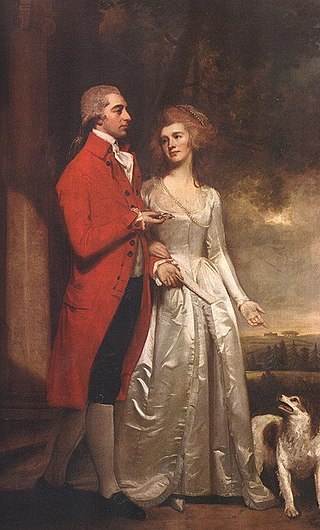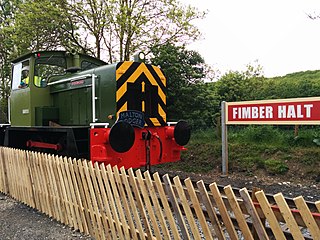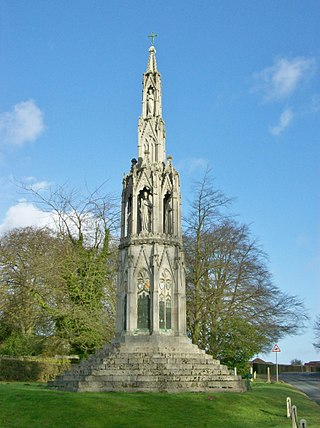This article needs additional citations for verification .(August 2008) |
The Sykes family of Sledmere own Sledmere House in Yorkshire, England.
This article needs additional citations for verification .(August 2008) |
The Sykes family of Sledmere own Sledmere House in Yorkshire, England.

The Sykes family settled in Sykes Dyke near Carlisle in Cumberland during the Middle Ages. The earliest correspondence in the Sykes archives relates to Richard Sykes (1678–1726), from his factors in Danzig and local gentry. William Sykes (1500–1577), migrated to the West Riding of Yorkshire, settling near Leeds, and he and his son became wealthy cloth traders.
Daniel Sykes (born 1632) was the first member of the family to begin trading in Hull and amassed a fortune from shipping and finance. Richard Sykes (1678–1726) diversified further, concentrating on the flourishing Baltic trade in bar iron, and the wealth of the family was built on this in the first half of the eighteenth century. He married Mary Kirkby, co-heiress to the Sledmere estates of Mark Kirkby, and, secondly, Martha Donkin. Two of his sons, Joseph Sykes (1723–1805) and Richard Sykes (1706–1761), managed the family business jointly. They were leading participants in the cartel in oregrounds iron, the raw material for blister steel. After Richard's death, Joseph continued this business alone, and members of the family continued it after his death until the 1850s. Joseph had bought estates around West Ella and Kirk Ella.
Mark Sykes (1711–1783) was rector of Roos, and 1st baronet. His correspondence includes letters from the London merchant Henry de Ponthieu about the French in Canada 1761–63 and circa 100 letters from his London banker, Joseph Denison. He was succeeded at Sledmere by his one surviving child, Christopher Sykes (1749–1801), who was MP for Beverley 1784–90. In 1770 he made a fortunate marriage with Elizabeth, the daughter of William Tatton of Wythenshawe, Cheshire whose inheritance of £17,000 from her father was hugely augmented by her inheriting her brother's Cheshire estates and another £60,000 from her aunt in 1780. Christopher Sykes sold off shipping interests and government stock and he and his wife expanded the Sledmere estate. They bought and enclosed huge areas of land for cultivation and built two new wings to the house. The grounds were landscaped and 1,000 acres (4.0 km2) of trees planted. The entire village of Sledmere was relocated. His correspondence includes two letters from the archbishop of York and about 270 letters from a wide range of people including William Carr of York and Henry Maister of Hull. Christopher Sykes's son, Mark Masterman Sykes (1771–1823), [1] was a knowledgeable collector of books and fine arts, but these were sold when he died childless. He was succeeded by his younger brother, Sir Tatton Sykes, 4th Baronet (1772–1863), who had an interest in agricultural techniques and horse racing.
Daniel Sykes (1766-1832) was son of Joseph Sykes, and served as a Member of Parliament for Kingston upon Hull and Beverley. [2]
His only son, Sir Tatton Sykes (1826–1913), developed into a rather withdrawn man who sold his father's stud for £30,000 and restored seventeen churches. He married Jessica Cavendish-Bentinck (died 1912). Their one son, Mark Sykes (1879–1919) travelled in the Middle East and wrote Through five Turkish provinces and The Caliph's last heritage. He married Edith Gorst, and their honeymoon took them to Paris, Rome, Constantinople and Jerusalem. They had six children. Mark Sykes was elected MP for Central Hull in 1911 and occupied himself for the early part of the First World War establishing the Waggoner's Special Reserve. From May 1915 he was called to the War Office by Lord Kitchener and is largely remembered for the part he played in forging the Inter-Allied agreement about the Middle East in 1916, the Sykes-Picot Agreement. While in Paris during the peace conference Mark Sykes contracted influenza and died at the age of only 39. He was a key figure in Middle East policy decision-making and his papers are a source of material on policy. Sir Mark Sykes 6th Baronet was succeeded in the title and Sledmere estates by Sir Richard Sykes 7th Baronet (1905–1978) and then Sir Tatton Sykes 8th Baronet, born 1943.
The family archives include correspondence with Winston Churchill, Austen Chamberlain, Chaim Weizmann, Arthur Balfour, Francois Georges-Picot, T. E. Lawrence, Nahum Sokolow, C P Scott, W Ormesby-Gore, Sir Ronald Storrs, Alfred Dowling, E G Browne, Francis Maunsell, Grant Dalton and Oswald Fitzgerald. [3]
The current baronet of the Sledmere House, Yorkshire, is Sir Tatton Sykes 8th Baronet, who has three brothers.

Sledmere House is a Grade I listed Georgian country house, containing Chippendale, Sheraton and French furnishings and many fine pictures, set within a park designed by Capability Brown. It is the ancestral home of the Sykes family and is located in the village of Sledmere, between Driffield and Malton, in the East Riding of Yorkshire, England. The present house was begun in 1751, extended in the 1790s, and rebuilt after a fire in 1911. It was once the home of Colonel Sir Mark Sykes, 6th Baronet, noted English traveller and diplomatic advisor, and is now the home of Sir Tatton Sykes, 8th Baronet.

Garton on the Wolds is a village and a civil parish on the Yorkshire Wolds in the East Riding of Yorkshire, England. It is situated approximately 3 miles (5 km) north-west of Driffield town centre and lies on the A166 road.

Sledmere is a village in the East Riding of Yorkshire, England, about 7 miles (11 km) north-west of Driffield on the B1253 road.
The Sykes Churches Trail is a tour of East Yorkshire churches which were built, rebuilt or restored by the Sykes family of Sledmere House in the East Riding of Yorkshire, England. The tour was devised by the East Yorkshire Historic Churches Group and is divided into a southern circuit and a planned northern circuit.

There have been four baronetcies created for persons with the surname Sykes, two in the Baronetage of Great Britain and two in the Baronetage of the United Kingdom. Three of the creations are extant as of 2008.

Sir Tatton Sykes, 5th Baronet was an English landowner, racehorse breeder, church-builder and eccentric.

Christopher Sykes was an English Conservative politician who sat in the House of Commons from 1865 to 1892. He enjoyed the "intimate friendship" of Edward VII when Prince of Wales and Alexandra of Denmark when Princess of Wales.

Cowlam is a hamlet in the civil parish of Cottam, in the East Riding of Yorkshire, England, and in the Yorkshire Wolds. The hamlet is on the B1253 Bridlington to North Grimston road, 17 miles (30 km) north from the county town of Beverley, 2 miles (3 km) east from the village of Sledmere, and 2.5 miles (4 km) north-west from the parish hamlet of Cottam. The hamlet contains eight houses and two farms.

Colonel Sir Tatton Benvenuto Mark Sykes, 6th Baronet was an English traveller, Conservative Party politician, and diplomatic advisor, particularly with regard to the Middle East at the time of the First World War.

Sir Christopher Sykes, 2nd Baronet was an English Tory politician and a Member of Parliament (MP) for Beverley from 1784 to 1790.
Sir Mark Sykes, 1st Baronet was a priest in the Church of England, Rector of Roos in the East Riding of Yorkshire. Sykes was created a baronet in 1783, shortly before his death; the baronetcy was originally designed for his son Christopher, who insisted it be conferred upon his father.

Sir Tatton Sykes (1843–1860), who also raced under the name Tibthorpe, was a British Thoroughbred racehorse and sire. In a career that lasted from spring 1846 to summer 1848 he ran eleven times and won four races. As a three-year-old in 1846 he won two of the three races which became known as the Triple Crown, taking the 2000 Guineas at Newmarket and the St Leger at Doncaster. He was considered by some to have been unlucky when he was narrowly defeated in The Derby. The rest of his career was a disappointment as he won only one race in the next two seasons. After being retired to stud he had some success as a sire of winners.

Wilbraham Egerton was a British landowner and Member of Parliament from the Egerton family.

Sir Mark Masterman-Sykes, 3rd Baronet, born Mark Sykes, was an English landowner and politician, known as a book-collector.

Sir Tatton Sykes, 4th Baronet (1772–1863) was an English landowner and stock breeder, known as a patron of horse racing.

The Wagoners' Memorial is a war memorial in Sledmere, in the East Riding of Yorkshire in England. The unusual squat columnar memorial was designed by Sir Mark Sykes, 6th Baronet and built in 1919–20. It became a Grade II listed building in 1966, upgraded to Grade I in February 2016. The memorial stands near the Eleanor Cross, Sledmere, a copy of the Eleanor Cross from Hardingstone, which was built as a village cross in the 1890s and converted by Sykes into a war memorial for the men from his estate.

The Yorkshire Wolds Railway is a preserved railway in the East Riding of Yorkshire, England. It is located on a section of the Malton and Driffield Junction Railway near the village of Fimber. The railway has a short demonstration line and an operational industrial diesel locomotive that provides cab rides to visitors. The railway has plans for expansion, work on which has been underway since April 2019.

A replica Eleanor Cross was erected in Sledmere, East Riding of Yorkshire, in 1896–98. The tall stone structure was constructed by the Sykes family of Sledmere. Engraved monumental brasses were added after the First World War, converting the cross into a war memorial.

St John of Beverley Church is a Roman Catholic parish church in Beverley, East Riding of Yorkshire, England. It was built from 1897 to 1898 in the Gothic revival style. It is located on the corner of York Street and the North Bar in the centre of the town. It is a Grade II listed building.
Christopher Simon Sykes is an English writer and photographer. He was born into the northern English landed gentry Sykes family of Sledmere, the third son of Sir Richard Tatton-Sykes, 7th Baronet of Sledmere. In addition to authoring fourteen books, his work has appeared in many magazines. He has also written and presented Upper Crust, a six-part television series on country house cookery for BBC Two. He is married, and has two children by his first wife.